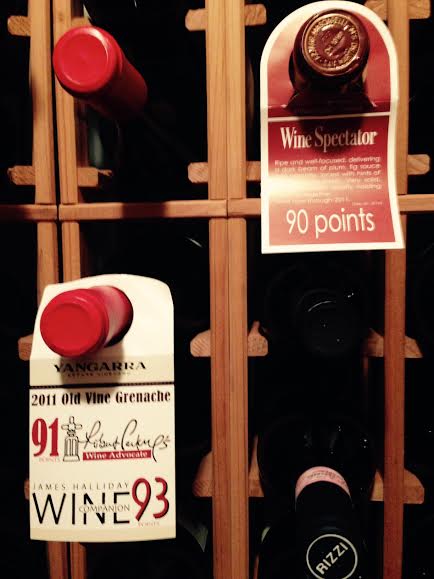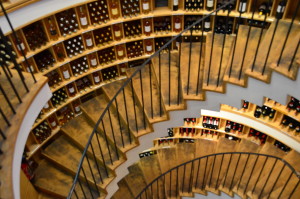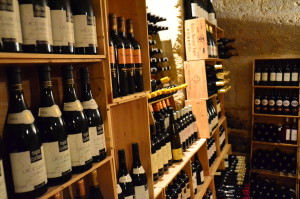
The Pitch –
I was recently in a wine shop standing by the “Syrah” section – this particular store grouped some of its wines by varietal rather than country of origin. A couple were next to me carefully going over each “bin” and had selected an Aussie Shiraz. They looked pleased with their choice which had a small note next to its price sign stating that a particular critic had awarded the wine a score of 91 points. The couple started to walk away when one of them stopped and said, “wait, here’s a 92”. Down went the Shiraz and up came a Cote du Rhone Village. Could they tell the difference between the full throttle Oz effort and the more austere French wine? Would one suit their tastes more than the other? It’s hard to say, but I’d suggest they wouldn’t have been able to detect a one point difference between two similar Australian offerings let alone the very different styles of wines they‘d considered. I’ll confess that I too would not have felt confident in assessing a one point qualitative difference between the two selections .
One of the troubles with scoring, is that it makes many of us lazy. Why bother to delve into a wine when it’s so much easier just to have someone else give it a score that we can treat as being irrefutable. But is that “score” written in stone? Should we even pay attention to the judgment of one critic when rendered in such an absolute fashion?
Cardinal vs Ordinal
Wine consumers might consider that the scoring of wines is not an exact science. For starters, the scoring arguably falls somewhat between ordinal and cardinal measurements. Many Canadians will recall the impact of the former during the 2002 Winter Olympics in Salt Lake City. A scoring “scandal” occurred involving the Canadian figure skating pair of David Pelletier and Jamie Salé. Ultimately, the duo received a gold medal, but the point here is that judges “score” figure skaters on a ranking basis (as against other skaters). In contrast, traditional slalom skiers at the Olympics are scored on a cardinal basis. That system employs a constant unit of measurement, in the case of the skiers, time. Whether it’s 100ths of a second, distance travelled, or weight lifted, cardinal ratings are as precise as the equipment that measures the increments in question. Ordinal ratings are, however, inherently subjective. Consider then, the rating of a bottle of wine. The measurement of quality is, arguably, a blend of approaches although I’d suggest it leans more to an ordinal characterization. A typical consumer might be happy to rank different wines in order of preference, but balk at assigning a score to each. At the same time, we might accept that an expert critic can render her/his judgment based on an “educated” palate, but even then, I’d argue that the rating is more opinion and not an absolute.
Choose Your Yardstick
There’s a further concern when it comes to rating wine. Not all rating systems are the same. Most North American wine drinkers are familiar with the 100 point system popularized by the ubiquitous critic, Robert Parker. The system is arguably a 50 point spread as it only scores wines starting at that number. From 50 to 60, the wine in question is considered to be unacceptable. From 60 to 70, you’re looking at a below average wine with noticeable deficiencies. 70 to 80 gets you to average while 80 to 90 can be barely above average to very good. 90 to 95 is an outstanding wine with 95+ being extraordinary. Careful however, Wine Enthusiast also uses the same 100 point range, but its scoring differs. For example, 90 to 94 rates an “excellent” with 95 to 98 being superb and above that, the wine is deserving of the “classic” accolade. Then there’s the 20 point scale used by Decanter magazine (the publication now also usually includes a conversion to the 100 point system in a nod to North American readers). Jancis Robinson and UC Davis also employ the 20 point scale, but again, their scoring descriptions within each usage vary. You can find 5 star systems (Michael Broadbent), 4 stars (the New York Times) and anything else you’d care to envision if you look for it.
Confused yet? Consider as well that the internal weighting employed by a given critic or a given system will also likely vary. For example, one critic might give much more weight to the bouquet of a wine whereas the other might emphasize taste over scent. The same is also true for the scoring system itself. You may end up scoring out of a 100, but the system you employ may give more points for colour than another critic’s 100 point system. And as you would guess, each critic brings his or her own preferences to bear. Mr. Parker is open in stating that he prizes concentrated, dense wines whereas Ms. Robinson leans towards a more elegant approach. Each are fully entitled to their own view, but I wonder if the average consumer appreciates the style choices of the two. I more often find myself in agreement with Ms. Robinson, but again, that’s just my take.
I believe it is also important to consider the context in which a wine is being reviewed and for that matter, enjoyed. Wine is tasted, by necessity, at one moment of its life in the bottle. Follow up tastings by experts may see the scores change for the same wine consumed at different times. I’ve even felt differently about two bottles of the same wine consumed at the same time – bottle variation is more prevalent than many might think. Clinical tasting settings and rapid fire analysis don’t lend themselves to a full assessment of a given wine. I’ve been to tastings where 50 or more wines are reviewed in rapid succession. There can be some advantages to this if you’re comparing one style of wine from different wineries, but overall, I prefer to sample a bottle of wine in a leisurely fashion. In my tasting notes, you can be assured that unless I mention otherwise, all of the reviewed wines have been consumed one bottle at a time over the course of an hour or two and usually with a meal. It’s worth remembering that wine is also tasted and “scored” by a given individual – he/she may have an off day, err, or simply have a decidedly different approach to wine from you or I. We bring something of ourselves to what we find in the glass.
Back To Basics
In the future, why not consider how you intend to drink a wine before relying on what was likely an almost instantaneous point assessment issued by a given critic. I’ll grant that if ten different experts all rate a wine at 95 points or better out of 100, you can be confident that it’s a pretty decent effort. But even then, is that the wine you should purchase for the occasion you have in mind? Wouldn’t you be better off seeking advice from your local wine shop owner who you’ve come to trust and who, in turn, has gotten to know your likes and dislikes? Perhaps the scoring of wines isn’t the real concern – perhaps the real problem is that the consumer is now placing too much emphasis on the scores. Certainly, the marketers of the wine aren’t shy about pushing the ratings on those wandering the store aisles. Points sell and higher scores can lead to higher prices.
My best advice? Feel free to check out the scores if you like, but keep in mind the subjectivity of those numbers. Short cut purchase decisions seldom work as well as taking a little time to consider when and where your wine will be enjoyed, the food it will be served with, and the people who will enjoy it. Cultivate your own tastes over time and call upon available expertise such as that found in a wine store with a good reputation. Most shops have knowledgeable staff only too willing to assist you in making a great selection. If they aren’t into it, find another store. Over time you’ll be rewarded with service and recommendations geared to your own preferences.

